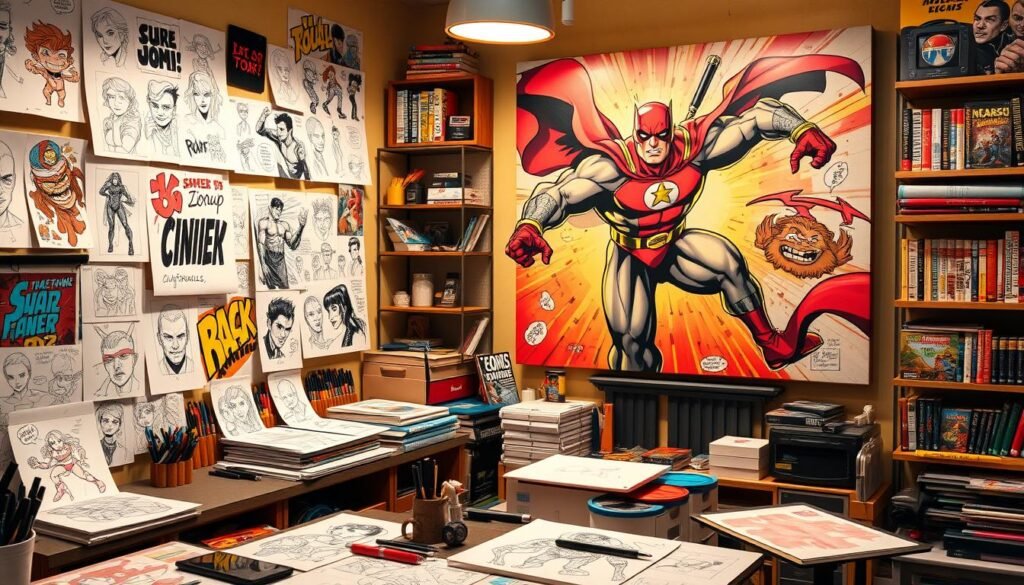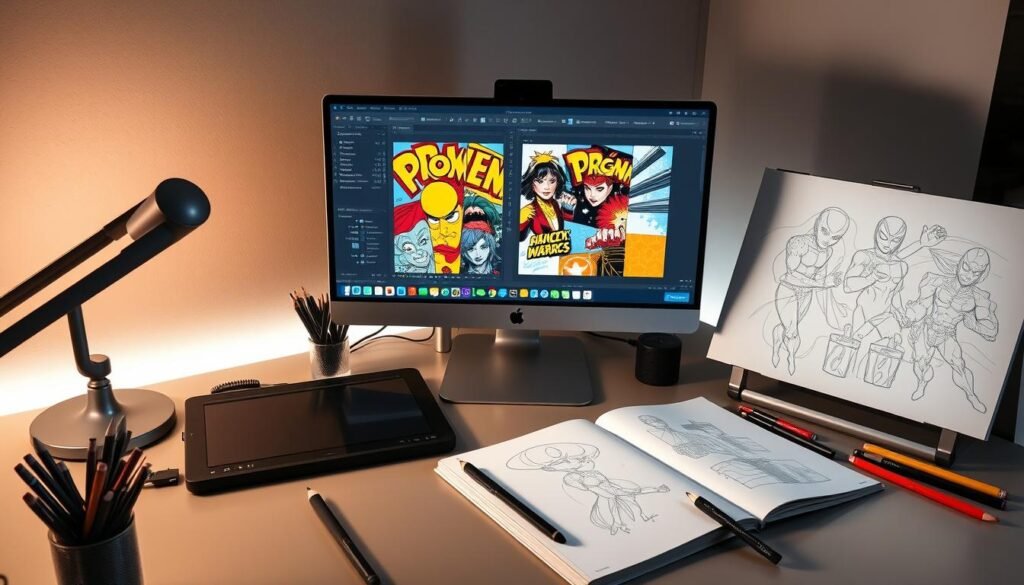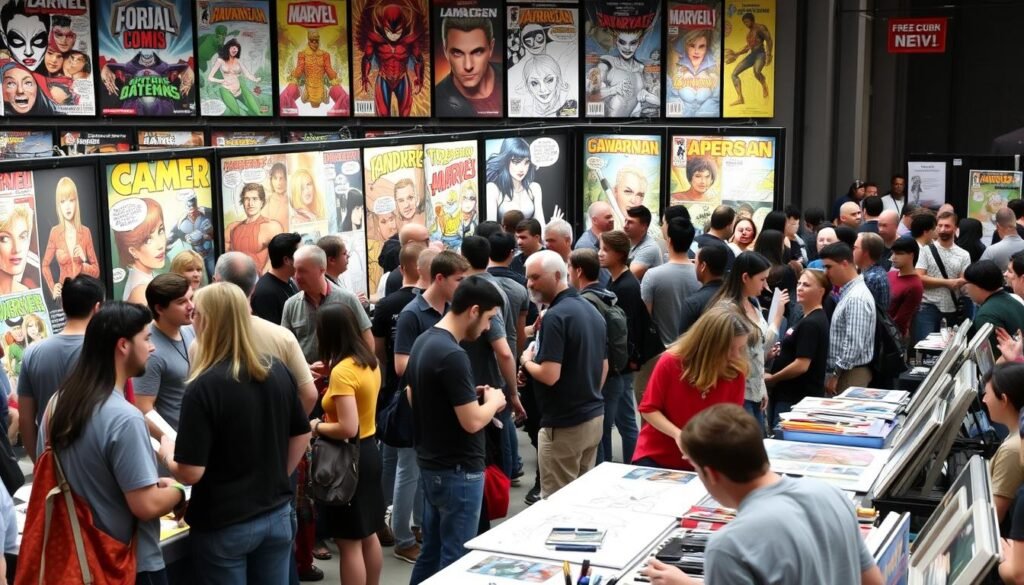Imagine a world where your imagination and art come together. This is the world of comic book artists. Here, dreams turn into reality, one panel at a time1.
Starting as comic book artists, we dive into a journey of passion and hard work. The field is tough, with few spots for artists1. We must work long hours, up to 12 a day, to get better and better1.
Drawing every day is key to growing as artists1. We learn about figures, anatomy, and storytelling. We aim to draw fast and well1. The road to success is long, but with practice and drive, we can make it1.
On our journey, we face many challenges. The main difference between hobbyists and pros is the commitment to quality work. This often means more time and effort than expected1.
Key Takeaways
- The comic book industry is highly competitive with limited opportunities for professional artists.
- Aspiring artists must be willing to dedicate long hours, often up to 12 per day, to hone their craft.
- Consistent daily drawing practice and the ability to produce at least one comic page per day are essential for success.
- Mastering a broad set of skills, including figure drawing, anatomy, backgrounds, and storytelling, is critical.
- Becoming a professional comic book artist requires unwavering dedication, passion, and a relentless drive to excel in the craft.
Understanding the Role of a Comic Book Artist
Aspiring cartoonists, pencillers, and inkers need to grasp the role of a comic book artist. The process of creating comics is like filmmaking. It involves a team working together to tell a story2.
What Does a Comic Book Artist Do?
A comic book artist turns the writer’s ideas into pictures. They sketch out the story, draw detailed pictures, ink them, and sometimes color the pages3. The writer writes the script, and the artist brings it to life with drawings3.
Key Responsibilities in Comic Book Art
- The penciller creates the first drawings, focusing on how the story moves and characters act3.
- The inker adds depth and mood with strong lines and shading3.
- The colorist picks the colors, setting the mood and look of the comic3.
- The letterer makes sure the story is easy to read by adding text and sound effects3.
Working together, writers and artists turn the script into a story that readers can enjoy3. The artist’s role is key, and their work is often credited in the comic3.
| Role | Responsibilities |
|---|---|
| Writer | Creates the story, dialogue, and overall story beats |
| Penciller (Director) | Brings the story to life visually, handles paneling, character movements, camera angles, and pacing |
| Inker (Lighting) | Creates mood with light and dark, ensuring depth and clarity in the artwork |
| Colorist | Picks the colors, adding depth, mood, tone, and emotion to the visuals |
| Letterer (Sound) | Makes the story easier to read, guiding the eye, and enhances storytelling |
Comic book creation is a team effort. It allows for creativity and input from everyone involved, making the story more engaging2.
“Collaboration among team members is vital, allowing for shared opinions and creative input to enhance the final product.”
For aspiring cartoonists, pencillers, and inkers, understanding their roles and the teamwork needed is key to success in this exciting field243.
Essential Skills for Aspiring Comic Book Artists
To become a pro comic book artist, you need to learn many drawing techniques and artistic skills. Skills like figure drawing, perspective, shading, and rendering are key. Aspiring5 colorists, letterers, and storyboard artists must work hard to create amazing characters and stories.
Drawing Techniques We Should Master
Learning to draw the human body accurately is very important. Artists need to study the human form to draw faces, body language, and movement well5. Being good at drawing figures from different angles helps make characters look real and consistent.
Comic book artists also need to get good at telling stories through pictures5. They must know how to place text and arrange panels to guide the reader. Good layout and panel design are key to telling a story well.
Understanding Composition and Layout
Knowing how to arrange panels and design pages is critical for comic book artists5. They need to create layouts that make the story pop. Aspiring6 artists should look at the work of greats like Jim Lee and keep practicing.
Becoming a great comic book artist takes a lot of hard work and learning5. With regular practice and a focus on improving, artists can develop their own style. They can then bring their stories to life in a unique way.
Finding Your Artistic Style
Aspiring comic creators and graphic novelists need a unique style to stand out. While a personal style isn’t a must before selling art7, it takes time to develop7. But, with the right steps, you can speed up this process in about a week7.
The Importance of Unique Style
A unique style makes your work stand out. It attracts publishers and readers. By trying out different techniques and mediums, you can express your unique voice. Looking at the work of others can inspire you, but don’t copy them8.
Tips to Develop Our Style
Here are some tips to find your style:
- Set aside time each day for art to stay motivated8.
- Make a Pinterest board to see what art you like8.
- Try a 30-day challenge to focus on your style8.
- Join online communities to get feedback and ideas from others9.
- Keep trying new things and let your style grow8.
Finding your style is a personal journey. It takes different times for everyone8. Enjoy the process, and let your style grow and change8.

“Developing a personal art style is a deliberate process that can be accelerated through a step-by-step method, allowing hundreds of artists to find their unique voice.”7
Tools of the Trade: What We Need
As illustrators and comic book artists, we use many tools to create our art. We need everything from pencils and inks to digital software and hardware. The right tools are key to our success and the quality of our work.
Traditional Tools for Comic Book Artists
Many comic book artists love traditional media. Blue pencils, like the Col-erase light blue, are great for initial layouts. They disappear when scanned or photographed10. Bristol board, such as Strathmore series 300, is also popular for layouts10.
We work on different paper sizes, from 11 x 14 inches to 9 x 12 inches, depending on the project10. For penciling, we often use Staedtler Lumograph F and Papermate10. Inking is done with a Windsor & Newton Series 7 sable watercolor brush, and we prefer the #2 size10.
For details, we use Faber-Castell Pitt Artist pens and Microns for finer lines10.
Digital Tools and Software Recommendations
Digital tools are now very popular among comic book artists. Software like Adobe Photoshop, Clip Studio Paint, and Procreate are favorites. Graphic tablets and pen displays, such as Wacom Cintiq, are essential for digital artists. 
When working digitally, we scan our artwork at 600 dpi in black and white or lineart files10. Digital cleanup in Photoshop fixes any stray lines or imperfections before finalizing the art files for production10. For full-length books, coloring is usually done by professional colorists using Photoshop10.
Whether we like traditional or digital tools, investing in quality materials and software is important. It helps us create amazing comic book art101112.
Building Our Portfolio
As aspiring comic creators and graphic novelists, a strong portfolio is key. It shows off our talents and draws in new chances. Our portfolio should show we can do many things, like design characters and tell stories in sequence13.
What to Include in Our Portfolio
Our portfolio should have complete comic pages, character designs, and concept art. This shows we’re versatile and have a unique style13. It’s also important to keep it short and professional, focusing on our best work13.
Tips for Showcasing Our Work Effectively
We should also have an online portfolio for easy access and updates13. When applying for jobs or projects, tailor our portfolio to fit what the publisher or client wants13.
To make our portfolio better, add process work like thumbnails and sketches. This shows our creative process and attention to detail14. Also, give credit to any collaborators, like writers or colorists, to build professional connections14.
In the end, our portfolio should show our unique style and versatility. By making a professional and accessible portfolio, we boost our chances of getting exciting opportunities. This helps us grow as comic creators and graphic novelists14.

Networking in the Comic Book Industry
Networking is key for aspiring comic book artists and illustrators. The field is tough, with only 1% of artists and writers making it big15. But, by making connections, we can find jobs, collaborate, and get mentorship.
Why Networking Matters
Networking is more than just making friends. It’s about building a team that helps us grow. About 70-80% of creators work on contracted jobs to keep going15. Connecting with editors can help get our work seen, as they often look for new talent15.
How to Connect with Other Artists and Professionals
There are many ways to meet other artists and pros. Going to comic conventions and networking events is a big help16. Also, being active on Twitter, Instagram, and TikTok can show off our work and connect us with others15.
Being professional, respectful, and true to ourselves is key when meeting others in the field. It’s smart to mix work-for-hire jobs with our own projects to avoid burnout15. Staying persistent is also key, showing our dedication to our craft and networking15.

By networking and building relationships, we can find new chances, learn from others, and reach our goals as comic book artists and illustrators.
Getting Published: Traditional vs. Self-Publishing
Aspiring comic creators and graphic novelists have choices for publishing. Traditional publishing, through big names like Marvel and DC, offers wide reach and support. But, it’s very competitive17. Self-publishing, like webcomics and crowdfunding, lets us control our work and earn more. Yet, it demands marketing and business skills18.
Pros and Cons of Traditional Publishing
Traditional publishing has benefits, like the help of publishing houses17. But, it also means giving up a lot of money18. The process is slow, with agents and editors looking at market trends17.
Exploring the Self-Publishing Route
Self-publishing lets us keep creative control and earn more18. But, we must handle the business and marketing, which is hard18.
Choosing between traditional and self-publishing depends on our goals and resources1718. Weighing the pros and cons helps us make the best choice for our careers.

“Choosing the right publishing path is a critical decision that can significantly impact our careers as comic creators and graphic novelists.”
| Traditional Publishing | Self-Publishing |
|---|---|
|
|
Marketing Ourselves as Comic Book Artists
Aspiring comic book artists need to promote themselves to succeed. A professional website and active social media are great starting points19. Sharing our work, progress, and behind-the-scenes moments helps us connect with fans and clients.
Strategies for Promoting Our Work
Going to comic book conventions and art shows is also key20. We can sell prints or merchandise to earn extra money and get noticed. Working with other artists or writers can also grow our audience.
Utilizing Social Media to Our Advantage
Social media is vital for comic book artists to reach their audience19. Posting interesting content, talking to followers, and using influencer marketing can build a loyal fan base. Being true to ourselves and consistent in our brand helps us stand out.
| Marketing Strategies | Potential Benefits |
|---|---|
| Professional Website | Showcase our portfolio, connect with clients |
| Social Media Platforms | Engage with fans, build a following, promote our work |
| Attending Conventions | Network with industry professionals, sell merchandise |
| Collaborations | Expand our audience, cross-promote with other artists |
| Merchandising | Supplemental income, increase brand visibility |
By using a mix of online and offline marketing, we can promote our work well. As comic book artists and illustrators, we can connect with our audience and build a successful career in comic book art.
“Consistency and authenticity in our marketing efforts are key to building a loyal fan base.”
Staying Inspired and Creative
As comic creators and graphic novelists, it’s key to keep our creativity flowing. We find inspiration in many places, like art, nature, and our own lives21. We also need to try new things and explore different styles to grow as artists.
Finding Creative Inspiration
We should dive into the works of other artists, from comics to movies and books22. Watching our favorite movies, reading books, and listening to music can spark new ideas. This helps us see things from different angles and improve our storytelling.
Techniques to Overcome Artist’s Block
Every artist faces times when they can’t create. When this happens, we need to find ways to get past it21. Changing our surroundings, working with others, or doing personal projects can help. Having a routine and setting goals keeps us focused and motivated, even when we’re not feeling inspired.
By keeping our creativity alive, we can keep growing as comic creators and graphic novelists. Positive feedback from our readers drives us to do even better. It pushes us to reach new heights in our work21.
| Strategies to Overcome Artist’s Block |
|---|
| – Listen to music for inspiration |
| – Set personal deadlines and goals |
| – Visualize exciting scenes to be drawn |
| – Work on multiple projects simultaneously |
| – Read other comics and graphic novels |
| – Take breaks to recharge creative energy |
“Creativity is a skill that can be developed and maintained through consistent practice and exploration.”
By using these strategies, we can stay creative and overcome challenges. The most important thing is to stay curious, flexible, and committed to our craft21.
Continuing Our Education as Comic Book Artists
As comic book artists, we never stop growing. Learning continuously is key to improving our skills and staying current. Comic Art Ed!23 offers great workshops and courses for us to learn more.
These workshops are in the New England area and welcome everyone23. They cover basics like comic-making and character design. They also dive into zines, printmaking, and professional development for teachers23. By attending, we can grow our artistic skills and meet our education needs23.
Online courses and resources are also important. Books like “Understanding Comics” by Scott McCloud and “Comics and Sequential Art” by Will Eisner are must-reads. Online tutorials, industry podcasts, and artist interviews are great for learning and getting inspired as we keep improving our craft24.
FAQ
What does a comic book artist do?
What are the key skills required to become a professional comic book artist?
How can we develop a unique artistic style?
What tools do comic book artists use?
How do we build a strong portfolio as a comic book artist?
Why is networking important in the comic book industry?
What are the options for publishing our comic book work?
How can we effectively promote ourselves as comic book artists?
How do we stay inspired and creative as comic book artists?
What resources are available for continuous learning as comic book artists?
Source Links
- What Does It Take to be A Professional Comic Book Artist? – https://medium.com/swlh/what-does-it-take-to-be-a-professional-comic-book-artist-23e2ea4a8df8
- Different Roles in Comic Books – Matthew Childers – https://matthewchilders.com/different-roles-in-comic-books/
- Comic Book Creative Teams: Who’s Who And What Do They Do? – Creator Resource – https://www.creatorresource.com/comic-book-creative-teams-whos-who-and-what-do-they-do/
- Comic Book Artist – Salary, How to Become, Job Description & Best Schools – https://www.onlinedegree.com/careers/arts-design-entertainment/comic-book-artist/
- Essential Skills For Comic Book Artists – https://comicbooktutor.wordpress.com/2009/11/07/essential-skills-to-become-a-comic-book-artist/
- ULTIMATE Guide to Becoming a Comic Book Writer [2024] – https://www.frankgogol.com/writing-comics/the-ultimate-guide-to-creating-your-own-comic-book/
- Find Your Own Artistic Style and Find it in Less Than a Week – https://copicmarkertutorials.com/how-to-find-your-own-personal-drawing-style/
- How to Find Your Art Style: 14 Rules to Guide You | Sketchbook Skool – https://sketchbookskool.com/blog/how-to-find-your-art-style/
- Where to Find an Artist for Your Comic Book [2024] – https://www.frankgogol.com/making-comics/where-to-find-an-artist-for-your-comic-book/
- Graphic Novels: The Tools of the Trade — GoRaina! – https://goraina.com/blog/2013/08/graphic-novels-the-tools-of-the-trade
- Tools of the Trade: Traditional Inking – https://makingcomics.com/2014/09/09/tools-trade-traditional-inking/
- How to Draw Comics – Tools – Dirk I. Tiede – https://www.dirktiede.com/2017/10/09/how-to-draw-comics-tools/
- What To Include In Your Portfolio: A Guide for Comic Creators – Creator Resource – https://www.creatorresource.com/what-to-include-in-your-portfolio/
- How To Build A Comic Portfolio – https://www.wildstarpress.com/curiosityscorner/how-to-build-a-comic-portfolio
- How to Build a Career in the Comics Industry: Networking with Key People – https://medium.com/@brittabuescher/how-to-build-a-career-in-the-comics-industry-networking-with-key-people-c86075bd2f76
- Networking and the High Cost of Comic Conventions – Jim Keefe – https://www.jimkeefe.com/archives/1175
- Traditional Publishing for Cartoonists — Comic Art Ed! – https://comicarted.com/blog/2024/1/3/traditional-publishing-for-cartoonists
- Comparing the Initial Steps of Traditional Publishing and Self-Publishing – https://www.grekoprinting-comixwellspring.com/blog/comparing-the-initial-steps-of-traditional-publishing-and-self-publishing/
- Comic Book Marketing | A Comprehensive Guide – https://updates.kickstarter.com/the-comic-book-marketing-blueprint-a-step-by-step-guide-to-success/
- Ep 12: How to self publish your own comic book with Tatiana Gill — Women of Illustration – https://www.womenofillustration.com/episodes/self-publish-comic-book
- Staying motivated and gaining motivation back: share your tricks! – https://forums.tapas.io/t/staying-motivated-and-gaining-motivation-back-share-your-tricks/3093/21
- On leaning into inspiration – https://thecreativeindependent.com/people/comic-book-artist-james-tynion-iv-on-leaning-into-inspiration/
- Visits — Comic Art Ed! – https://comicarted.com/visits
- Visual Storytelling and Comic Arts – Massachusetts College of Art and Design (MassArt) – https://massart.edu/program/visual-storytelling-and-comic-arts/
